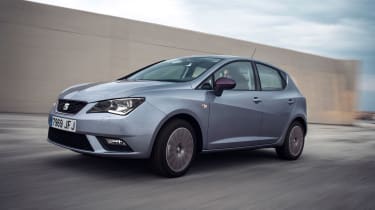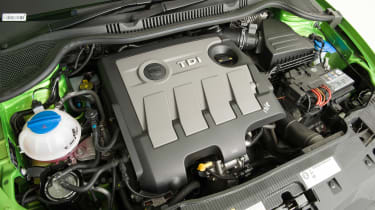Used SEAT Ibiza (Mk4, 2008-2017) - What's it like to drive?
Given SEAT’s reputation for Latin flair, it’s no surprise to find the Ibiza is good to drive with a range of zesty engines
With its compact dimensions and a firmer suspension set-up than many similar era rivals, the agile Ibiza is good fun to drive. Some of the entry-level engines struggle on the open road, but the turbocharged TSI petrol and large TDI diesel serve-up eager performance. It’s not as comfortable and quiet as some, but the SEAT is more than capable of tackling longer journeys.
Engines and performance
Early versions of the Ibiza were available with naturally aspirated four-cylinder 1.2 and 1.4-litre petrol engines. With just 69bhp, the former is a sluggish performer, needing 14.5 seconds for the 0-62mph sprint. The larger unit mustered 84bhp, which means its good for a claimed 11.4 seconds over the same acceleration test.
From 2015 onwards the entry level engine was the 74bhp 1.0-litre, which claims 0-62mph in 14.3 seconds and a top speed of 107mph. Sporty FR models could be specced with a 109bhp version of the same engine, but here it delivers 200Nm of torque and is hooked up to the DSG gearbox. The result is 0-62mph in 9.3 seconds and a 122mph maximum.
In between these two is the 94bhp EcoTSI turbo version of the 1.0-litre three-cylinder, which offers the best compromise in terms of performance and economy. In combination with a snappy five-speed manual gearbox, the engine’s performance builds progressively and delivers a 0-62mph time of 10.4 seconds and a 119mph top speed.
Used - available now

2021 Seat
Ibiza
27,270 milesManualPetrol1.0L
Cash £10,387
2021 Seat
Ibiza
45,406 milesManualPetrol1.0L
Cash £12,287
2018 Seat
Ibiza
34,745 milesAutomaticPetrol1.0L
Cash £11,787
2021 Seat
Ibiza
44,210 milesManualPetrol1.0L
Cash £10,563Next up is the four-cylinder petrol 1.2-litre. It’s available with 89bhp or 109bhp in the FR model, and claims 0-62mph in 10.7 seconds or 9.1 seconds respectively, as well as top speeds of 114mph or 122mph.
If you want a petrol model that goes faster, you need the four-cylinder 1.4-litre EcoTSI FR. This offers 148bhp and 250Nm of torque, which is enough for a 7.6-second 0-62mph time and a 137mph top speed.
Quicker still are the Cupra and Bocanegra models, which share the same novel twin-charged (its features both turbocharger and supercharger) 178bhp 1.4-litre. Mated exclusively to a seven-speed DSG twin-clutch gearbox it can scrabble from 0-62mph in 7.2 seconds and hit nearly 140mph - thought there are reliability concerns.
In 2016 this engine was replaced by an even more powerful but more conventional 189bhp turbocharged 1.8-litre that was available with a six-speed manual. With more power it can rattle off the 0-62mph dash in a rapid 6.7 seconds.
Over the years there have been plenty of TDI diesel engine options available in the Ibiza. The super-efficient Ecomotive model was originally available with the three cylinder 1.2-litre that produced 74bhp and could complete 0-62mph in 13.5 seconds. There was also a 1.4-litre TDI that produces the same power, yet with its extra torque can lower the acceleration time to 12.6 seconds. However, both have a decent amount of mid-range muscle so feel faster than the figures suggest, although their noisy and clattery soundtrack discourages hard use.
The larger four-cylinder 1.6-litre TDI packed 104bhp and lowered the 0-62mph sprint to a brisk 10.2 seconds, while refinement was improved. For the sporty FR model there was also a larger 141bhp 2.0-litre diesel that was available from 2010 to 2015. This delivered hot hatch performance, with 0-62mph taking just 8.3 seconds. Crucially, with 320Nm of torque it had more mid-range muscle than a similar era Porsche Boxster.
From 2015 there was only a single diesel engine in the Ibiza, but the 1.4-litre TDI is offered with 74bhp, 89bhp or 104bhp. The entry-level version is available in standard or Ecomotive guise, with the latter tuned for fuel economy rather than pace – it takes 13 seconds to cover 0-62mph. The most powerful TDI powers the fastest diesel Ibiza FR, delivers 250Nm of torque and promises 0-62mph in 9.9 seconds and a 119mph top speed.
On the road
While it's not as sharp as the similar era Ford Fiesta, the SEAT Ibiza is more engaging to drive than the Volkswagen Polo on which it’s based. It's nimble around town and equally capable on the open road.
Some buyers will find the suspension a little harsh, but SEAT tweaked it as part of the update to the range in 2015 in a bid to take the edge off. Even so, buyers who prefer a softer ride may be better to opt for the Polo.
The driving position in the SEAT Ibiza is excellent, adding to the sense of involvement behind the wheel. And no matter which model you go for, there's not much body roll in corners, while the steering is quick. If only it provided a little more feedback.
The FR versions feel a bit sportier, while the flagship Cupra’s extra performance makes it feel more fun. Yet neither is as engaging or entertaining as Ford Fiesta ST or Peugeot 208 GTi of the same age thanks to controls that lack feel and handling that’s not as adjustable as more fleet-footed similar era rivals such as a Renault Clio RS200.
The Ibiza came with a five or six-speed manual gearbox, depending on the engine size. There was also an automatic option, in the shape of the seven-speed twin-clutch DSG system sourced from Volkswagen.









